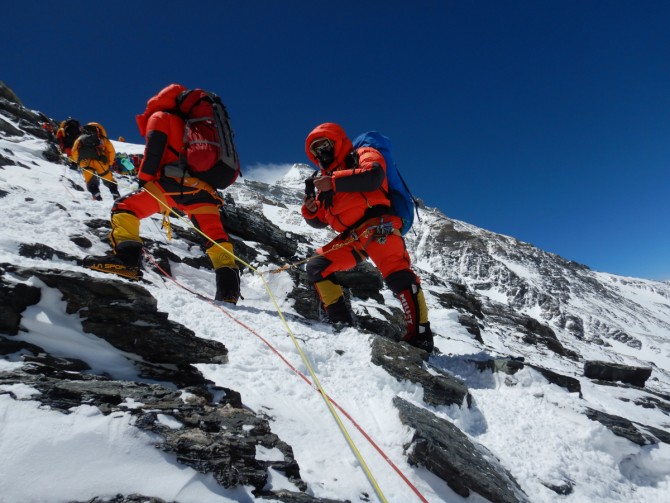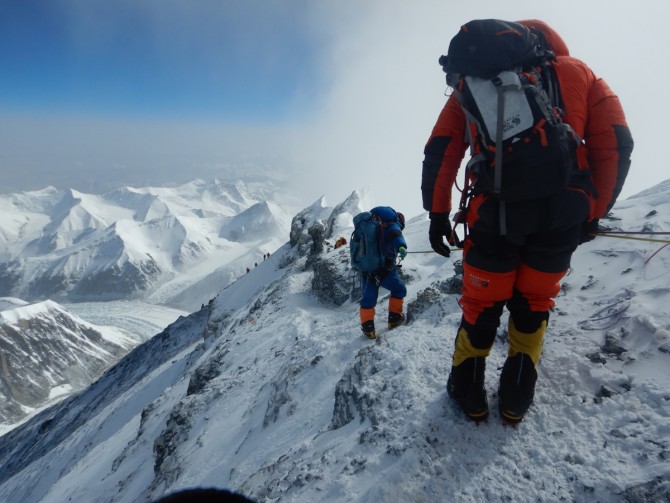
Deeya Bajaj ’16 and her father, Ajeet, hold Cornell signage at Camp 1 on Mount Everest after returning from the summit.
Everest climb a message for female equality
By Matt Hayes
As dawn approached over the icy caps of the Himalayas on May 16, Deeya Bajaj ’16 made her final, exhausting push to fulfill a lifelong journey: ascending the summit of Mount Everest.
Braving the climb with scarce oxygen, blinding sunlight and dangerous winds, she reached the world’s tallest peak with her father, Ajeet Bajaj, becoming the first Indian father-daughter duo to make the climb. There, at the roof of the world, she offered a message of female empowerment for other Indian girls.
Bajaj, who majored in natural resources at the College of Agriculture and Life Sciences, is the third Cornellian in recent memory to make the summit, following in the footsteps of Rob DesLauriers ’87 and Sean Mooney ’08, who made the climb in 2006 and 2013, respectively. She recently discussed how Cornell prepared her for the adventure, the elation at reaching the top, and how scaling the world’s tallest peak carried with it a message of gender equality for young women in India.
Climbing the world’s tallest peak is a treacherous undertaking. Why do it?
Adventure has been a way of life for me since a very young age. My father is a renowned adventurer and explorer: he is the first Indian to have skied to both the North and South poles. Further, my parents run an adventure tourism company in India. I have been on a number of extreme expeditions with my father, including a cross-country ski expedition across the Greenland Icecap when I was 17 and a mountaineering expedition to Europe’s highest point, Mount Elbrus. I was extremely excited when the opportunity came up, as attempting Everest was always a dream.
What did this mean to you as a role model for young females in India?
India is a rapidly developing country, and while we are doing very well in many fields, I do believe there is much scope for improvement as far as gender equality issues are concerned. Female feticide and limited opportunities for girls are some of the issues that are prevalent, especially in rural India.
When my father and I decided to climb together, we knew this would be a great opportunity to spread awareness about these issues. In a country where many families do not support girls and their aspirations, we wanted to show that given the right opportunities, our girls can reach any summit.
Can you describe the feeling when you reached the top?
I reached the summit while it was still dark – around 4:30 a.m. While at the top, the sight of the rising sun was surreal. I was very happy and excited that I had made it and that the months of preparation had paid off – but the elation was soon replaced with a feeling of apprehension. Our summit push began at 9:30 p.m. the previous night, and since it was dark, all I could see with the headlamp was the path ahead of me. Climbing down, however, we were in daylight. All of a sudden I could see the steep falls from the ridge, and that was scary. While climbing has its own set of challenges, the way down is significantly more treacherous.
How did your time at Cornell prepare you for what you’re doing now?
I am currently working with my parents in India, who own an adventure tourism company called Snow Leopard Adventures. As a company that is involved in introducing people to the great outdoors, my natural resources major helped me better understand how to minimize our impact on the environment and local people.
My time spent with Cornell Outdoor Education (COE) was invaluable. I taught two physical education classes – pool paddling and whitewater kayaking – and was the coordinator for Outdoor Odyssey, a fantastic outdoor based pre-orientation program. Working with COE helped me gain experience in planning and organizing trips and greatly improved my outdoor skills.
While at Cornell, did you have favorite places for outdoor adventures on campus or elsewhere in New York?
The Finger Lakes are absolutely beautiful and I would try and go out on hikes and kayaking trips around Ithaca as much as possible. One of my favorite experiences was kayaking down the Moose River in the Adirondacks.
Do you have any advice for others who dream of pushing themselves to the limit like this?
First, there is no substitute for being extremely well prepared. For a year before the expedition, every free minute I had was spent either training or doing research for the expedition.
Second, staying positive is crucial. There were many times on the mountain where the going got extremely tough. I realized that whenever I started thinking negative or focused on the discomforts, it would greatly decrease my performance. We were in an error-free environment where even a small mistake can have extremely dangerous consequences. So I began focusing on everything positive about the climb. Whenever I felt exhaustion creeping in, I would think about the cause of the girl child that was driving me. I would also think about my family back home and remember to remain focused for them.
Finally, I would keep reminding myself to be grateful, for just being on the beautiful Sagarmatha, as Mount Everest is called in Nepali, is an experience of a lifetime.
Matt Hayes is managing editor and social media officer for the College of Agriculture and Life Sciences.
Media Contact
Get Cornell news delivered right to your inbox.
Subscribe



